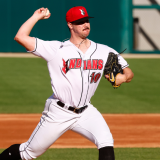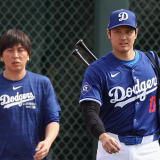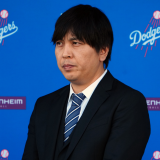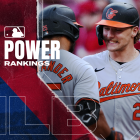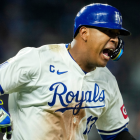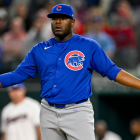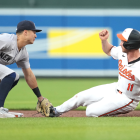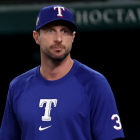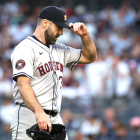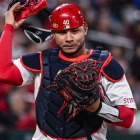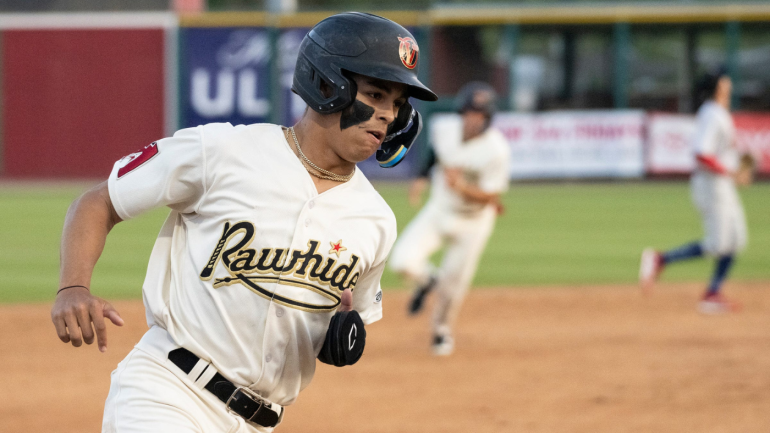
Major League Baseball's amateur draft is just over a month away. As such, this edition of Prospect Watch will highlight how each team's first selection from last year's draft has performed. We touched on the American League picks last week, that means it's time to scope out the National League. Do note that all the statistics used in this article are accurate as of Wednesday.
Now, with all the fine print out of the way, let's get to it.
| OF Druw Jones: Jones, the No. 2 overall pick, hasn't played much since being selected. He hurt his shoulder last year before he could make his professional debut, and he then injured his quad this year after appearing in 10 games. The upshot here is a plus center fielder who can bring the thunder, but he has to stay on the field for it to matter. | |
| RHP Owen Murphy: A two-way player in high school, Murphy has focused exclusively on pitching as a professional. That's the right call, as scouts have pointed out the similarities in his game to the likes of Jack Leiter and Jack Flaherty, among others. In eight starts at Low-A this season, he's amassed a 3.99 ERA and a 3.17 strikeout-to-walk ratio. | |
| RHP Cade Horton: Horton made himself a lot of money last summer by authoring a dominant run in the College World Series. The Cubs believed in his ability to pitch like that on a consistent enough basis to pluck him with the No. 7 pick. So far, so good. In eight starts across two levels, he's posted a 3.72 ERA and averaged an absurd 14 strikeouts per nine innings. | |
| 3B Cam Collier: The Reds had Collier, who had enamored teams because of his age-relative performance in junior college, slip to them at No. 18. He's struggled to date as a professional, hitting just .206/.309/.348 in his first 165 plate appearances. He's more than three years younger than his average competitor, so it's not worth hitting the eject button just yet. | |
| RHP Gabriel Hughes: The Rockies surprised other folks in the industry by drafting Hughes with the 10th pick since he was viewed as someone more likely to go in the second half of round one. He's performed fine so far, striking out nearly 13 batters per nine innings in eight High-A starts. | |
| C Dalton Rushing: The Dodgers did not make their first selection until pick No. 40. They made it count, as they so often have over the last decade. Rushing is sporting a .938 OPS at High-A and already looks like one of the better backstop prospects in the minors. | |
| 3B Jacob Berry: The Marlins appeared to reach when they took Berry at No. 6. Evaluators had concerns about his lack of defensive value (he's viewed as a future first baseman), as well as about his so-so exit velocities in college. He hasn't yet vindicated Miami. Instead, he has a .505 OPS and 39 more strikeouts than walks in his first 41 games at the High-A level. | |
| SS Eric Brown: Brown became the highest drafted player in Coastal Carolina history when the Brewers popped him at No. 27. He's spent this season in High-A, hitting for just a .711 OPS. He has stolen 22 bases on 24 tries, however, he's also made 10 errors in 34 games at shortstop. | |
| C Kevin Parada: The Mets had two early selections. They used their first pick, No. 11, on Parada, who had wowed scouts during his time at Georgia Tech. He's hit .243/.335/.384 with 29 more strikeouts than walks in 46 games at High-A. Their other top pick, shortstop Jett Williams, is batting .215/.407/.331 in Low-A. | |
| OF Justin Crawford: Crawford is a couple years younger than his average foe in the Florida State League, but that hasn't stopped him from posting an .824 OPS in his first 37 games. He's also made like his father, longtime big-league outfielder Carl, by stealing 23 bases on 26 tries. | |
| 2B Termarr Johnson: Johnson had plenty of boosters entering the draft, with one veteran scout giving him an 80-grade hit tool projection. He's more than two years the junior of his average competition in the Florida State League, but he's hitting .260/.421/.375 (the league-average OPS is .695) while seeing action at both middle-infield positions. | |
| RHP Dylan Lesko: Lesko was considered to be one of the top prep pitchers in the class before he required Tommy John surgery last spring. He's yet to make his pro debut as a result. | |
| 2WP Reggie Crawford: The Giants selected Crawford with the 30th pick even though he did not play during the 2022 season. It's understandable that San Francisco is easing him back into the swing of things, and to date he's recorded 5 1/3 innings and eight plate appearances. For whatever it's worth, scouts preferred him as a pitcher thanks to his power arm. | |
| LHP Cooper Hjerpe: Hjerpe, a funky lefty from Oregon State, looked to be on the fast track when he posted a 3.66 ERA over his first eight pro starts in High-A. He's currently sidelined with an undisclosed injury that will slow his ascent to the majors. | |
| OF Elijah Green: Green was considered to be the most volatile of the top prospects in last year's draft due to concerns about his hit tool. It's not particularly encouraging, then, that he's struck out 80 times in his first 45 games at Low-A. Green boasts a dynamic power-speed skill set, but it's to be seen if he finds a way to make enough contact for it to matter. | |






















